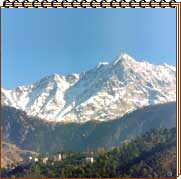|
 India's total land mass is 2,973,190 square kilometers and is divided into three main geological regions: the Indo-Gangetic Plain, the Himalayas, and the Peninsula region. The Indo-Gangetic Plain and those portions of the
India's total land mass is 2,973,190 square kilometers and is divided into three main geological regions: the Indo-Gangetic Plain, the Himalayas, and the Peninsula region. The Indo-Gangetic Plain and those portions of the
Himalayas within India are collectively known as North India. South India consists of the peninsular region, often termed simply the Peninsula. On the basis of its physiography, India is divided into ten regions: the Indo-Gangetic Plain, the northern mountains of the Himalayas, the Central Highlands, the Deccan or Peninsular Plateau, the East Coast (Coromandel Coast in the south), the West Coast (Konkan, Kankara, and Malabar coasts), the Great Indian Desert (a geographic feature known as the Thar Desert in Pakistan) and the Rann of Kutch, the valley of the Brahmaputra in Assam, the northeastern hill ranges surrounding the Assam Valley, and the islands of the Arabian Sea and the Bay of Bengal. Several major rivers, including the Ganges, Brahmaputra, and Indus, flow through India. Arising in the northern mountains and carrying rich alluvial soil to the plains below, these mighty rivers have supported agriculture-based civilizations for thousands of years.
The climate of India may be broadly described as tropical monsoon type. There are four seasons: winter (January- February), hot weather summer ( march- may), rainy south-western monsoon ( June- September) and post- monsoon, also known as the north-east monsoon in the southern peninsula ( October- December). India's climate is affected by two seasonal winds- the north-east monsoon and south-west monsoon. The north-east monsoon commonly known as winter monsoon blows sea to land after crossing the Indian Ocean, the Arabiab Sea and the Bay of Bengal. The south-west monsoon brings most of the rainfall during the year in the country.
Click on the following links to know more about INDIA.
India Facts and Figures |
History of India |
Geography of India |
Culture of India |
Economy and Infrastructure of India |
Future of India |
Map of India
| Recommended Tours |
Best of India Tour
Days : 08 Days / 07 Nights
Destinations : Delhi- Agra- Fatehpur Sikri- Jaipur- Udaipur
|
|
 |
|
|
 |
Splendid Rajasthan Tour
Days : 10 Days / 09 Nights
Destinations : Delhi-Udaipur-Narlai-Rohet-Jodhpur-Jaipur-Fatehpur Sikri-Agra
|
|
 |
Kerala Holidays Tour
Days : 13 Days / 12 Nights
Destinations : Cochin- Alleppey- Munnar- Periyar- Cardamom House- Madurai-Chennai
|
|
|
 |
| 
